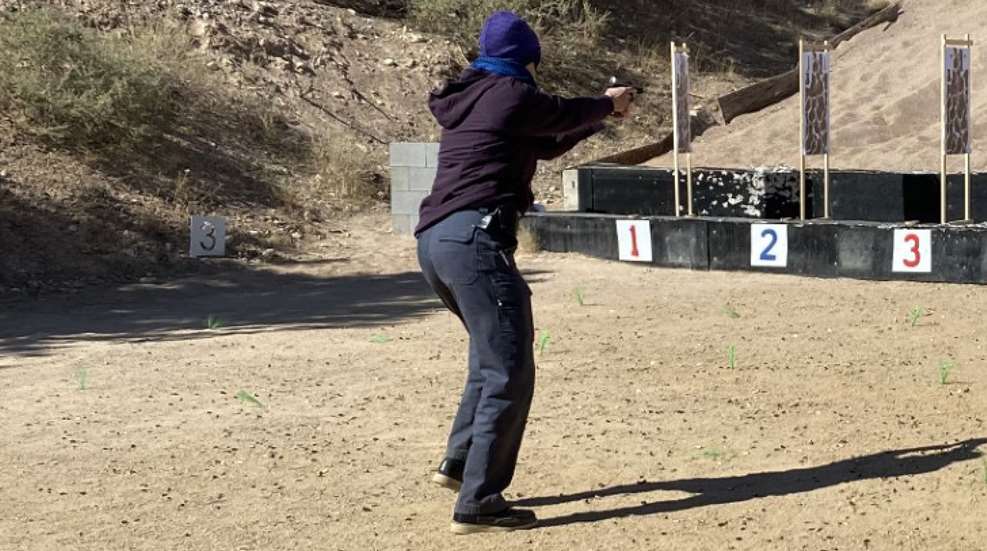
In criminal encounters, there are two types of attack range you need to be aware of. The first is the distance at which an individual can physically assault you without giving you any warning, represented by approximately arm’s reach; the second, which is longer, is the distance an armed individual can cover before you have time to draw and fire your concealed-carry firearm. When considering how close is too close, it’s important to understand both.
Arm’s-Reach Attack Range
Anyone who can physically reach you before you have time to react is by definition in “attack range” of you. This distance is actually a bit longer than arm’s reach—some experts define it as approximately the distance from the attacker’s eyebrows to the floor, if that distance were laid on the floor between you. Let’s just say that’s five and a half feet or so. Because self-defense is by definition reactionary (you aren’t acting, you’re reacting to something that’s happened, whether that’s an attack or a pre-attack indicator), anyone within about five feet of you can easily throw a punch or grab you before your brain even registers it’s happening.
For that reason, it’s important to keep anyone you are suspicious of outside immediate attack range and to move out of it if you’ve found yourself in it. Pay very close attention to how close someone gets when they approach you. You already know what’s a socially acceptable distance to stand from someone in various situations—“close” in a wide-open parking lot is not nearly as close as “close” in a crowded elevator, for example. Anyone who gets inside your definition of “close” should be treated suspiciously.
Never be afraid to put on your command voice and say “That’s close enough” to anyone who’s approaching you, and never be afraid to move away from someone who makes you uncomfortable. If a suspicious person has closed distance on you in a way that you can’t escape from, that’s a major red flag, and you should be in condition orange or maybe even red, depending on the other context clues.
Distance buys you time to react. The criminal already knows that, and he knows that if he rushes into your attack range from a distance away, you’ll notice and react. But if he slowly and subtly moves into range while engaging you in conversation, you’re less likely to notice him setting the trap until he’s close enough to spring it. Even better (for him), if he can get you to step into attack range yourself—which you might do with someone you’re arguing with or trying to scare off—you will put yourself in the trap and make his job easy.
Draw hard, firm boundaries about your personal space, and treat anyone who intentionally violates those boundaries as a problem, because they are. If you are trapped and can’t back up, do whatever you can to put distance or an obstacle between you. You can even try to maneuver yourself to one side—preferably to his left, which is statistically more likely to be his weak side. This increases the distance he has to move to reach you if he is right-handed. When you’re in this trapped situation, if the person who has you trapped does turn out to be a violent actor, you are in big trouble. Your best hope now is to try to fail his interview before he kicks off the violence. One way you can do that is by causing a scene if there is anyone without shouting distance. Another way is to shift your body into a bladed, “fighting” stance. As a women, you’re not very likely to intimidate a man into avoiding a physical fight with you, but just moving your body into an offensive stance lets him know that you know what’s going on, you’re not going to make this easy for him, and he still has time to select another victim.
Closing-the-Distance Attack Range
Back in the 1980s, a police trainer named Lt. Dennis Tueller developed what has become known as the 21-foot rule. Through an experiment, he found that the average police trainee could draw his firearm and fire two shots in the same amount of time it took an average man to cross 21 feet from a standing start. Thus, it became commonplace in self-defense circles to claim that anyone less than 21 feet from you could cut you with a knife before you had time to stop the attack, and anyone farther away than 21 feet could reliably be stopped, and therefore, 21 feet was considered a “safe distance” away unless the attacker had a firearm. Many self-defense gurus began teaching students this distance as a guideline on when to draw and shoot a firearm.
The 21-foot rule is still widely touted, but experts now agree that it’s bunk, for a lot of reasons. First, “average” is just average. You might be slower or faster than average; the attacker might be slower or faster than average. Second, the experiment involved shooters using open-carry holsters, and you’re probably concealed carrying, which automatically increases the time it takes you to draw. If you’re wearing heavy winter clothing, your draw will be even slower.
Third, if you’re not law enforcement, you don’t have the same goals, directives and legal protection as law enforcement does. Cops are required to deal with crazy armed people. You aren’t; you have the option to disengage if you’re able, and aside from that, it’s not common for a criminal to pull a knife on you from a considerable distance and then start charging you. He’s much more likely to get close to you (within arm’s-reach attack range) surreptitiously or with some kind of ruse, then reveal his weapon when he’s close enough to use it.
But perhaps most importantly, the shooters in the experiment were standing in front of a known, non-threatening, non-moving target on the range with a clear directive to fire. There was almost no reaction time built in other than the time it takes to hear the “fire” command. You, on the other hand, will be reacting to many stimuli at once. It will take your brain time to notice someone suspicious, note that they have a firearm, overcome your normalcy bias and realize that hey, this is a real problem I need to address immediately. You can work on shortening your reaction time and decision-making time through training, but you’ll never be as fast as a shooter standing in front of a target who is simply waiting on the command to fire. In addition, your target will be moving. You might be moving as well. It might be raining or foggy or dark or you might face some other condition that makes your vision less than ideal.
And, it’s worth noting that in Tueller’s original experiments, even the trainees who were able to get two shots off in the 1.5 seconds before the “attacker” reached them were often still “wounded” by the knife. Either shots weren’t center-mass or they were good kill shots but the attacker still had enough time to inflict damage while they were bleeding out.
At any rate, the 21-foot rule has been thoroughly debunked. You will need to rely on feeding context clues into your decision-making model to determine at what distance someone represents a threat, and therefore what distance you should draw and/or fire. Staying in condition yellow will help you notice potential problems before they get within arm’s reach attack range, and you should never be afraid to keep distance between yourself and someone you find suspicious. Move out of range if you can, and use your voice to establish a clear boundary. Anyone who violates that boundary and insists on staying inside your personal “too close” space should be treated as a potential threat.















































